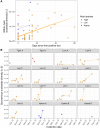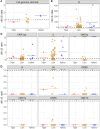This is a preprint.
SARS-CoV-2 within-host population expansion, diversification and adaptation in zoo tigers, lions and hyenas
- PMID: 39484504
- PMCID: PMC11527109
- DOI: 10.1101/2024.10.24.620075
SARS-CoV-2 within-host population expansion, diversification and adaptation in zoo tigers, lions and hyenas
Abstract
SARS-CoV-2 rapidly adapts to new hosts following cross-species transmission; this is highly relevant as novel within-host variants have emerged following infection of susceptible wild and domestic animal species. Furthermore, SARS-CoV-2 transmission from animals (e.g., white-tailed deer, mink, domestic cats, and others) back to humans has also been observed, documenting the potential of novel animal-derived variants to infect humans. We investigated SARS-CoV-2 evolution and host-specific adaptation during an outbreak in Amur tigers (Panthera tigris altaica), African lions (Panthera leo), and spotted hyenas (Crocuta crocuta) at Denver Zoo in late 2021. SARS-CoV-2 genomes from longitudinal samples collected from 16 individuals were evaluated for within-host variation and genomic signatures of selection. The outbreak was likely initiated by a single spillover of a rare Delta sublineage subsequently transmitted from tigers to lions to hyenas. Within-host virus populations rapidly expanded and diversified. We detected signatures of purifying and positive selection, including strong positive selection in hyenas and in the nucleocapsid (N) gene in all animals. Four candidate species-specific adaptive mutations were identified: N A254V in lions and hyenas, and ORF1a E1724D, spike T274I, and N P326L in hyenas. These results reveal accelerated SARS-CoV-2 adaptation following host shifts in three non-domestic species in daily contact with humans.
Keywords: SARS-CoV-2; spillover; virus evolution; within-host variants.
Figures






Similar articles
-
SARS-CoV-2 outbreak in lions, tigers, and hyenas at Denver Zoo.mSphere. 2025 Feb 25;10(2):e0098924. doi: 10.1128/msphere.00989-24. Epub 2025 Feb 6. mSphere. 2025. PMID: 39912638 Free PMC article.
-
SARS-COV-2 INFECTION AND LONGITUDINAL FECAL SCREENING IN MALAYAN TIGERS (PANTHERA TIGRIS JACKSONI), AMUR TIGERS (PANTHERA TIGRIS ALTAICA ), AND AFRICAN LIONS (PANTHERA LEO KRUGERI) AT THE BRONX ZOO, NEW YORK, USA.J Zoo Wildl Med. 2021 Jan;51(4):733-744. doi: 10.1638/2020-0171. J Zoo Wildl Med. 2021. PMID: 33480553
-
SARS-CoV-2 outbreak in lions, tigers and hyenas at Denver Zoo.bioRxiv [Preprint]. 2024 Oct 16:2024.10.14.617443. doi: 10.1101/2024.10.14.617443. bioRxiv. 2024. Update in: mSphere. 2025 Feb 25;10(2):e0098924. doi: 10.1128/msphere.00989-24. PMID: 39464021 Free PMC article. Updated. Preprint.
-
SARS-CoV-2 in animals: potential for unknown reservoir hosts and public health implications.Vet Q. 2021 Dec;41(1):181-201. doi: 10.1080/01652176.2021.1921311. Vet Q. 2021. PMID: 33892621 Free PMC article. Review.
-
SARS CoV-2 infections in animals, two years into the pandemic.Arch Virol. 2022 Dec;167(12):2503-2517. doi: 10.1007/s00705-022-05609-1. Epub 2022 Oct 7. Arch Virol. 2022. PMID: 36207554 Free PMC article. Review.
References
Publication types
Grants and funding
LinkOut - more resources
Full Text Sources
Miscellaneous
